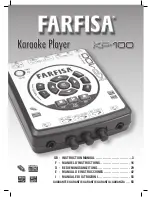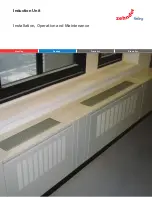
menor a 10. Debe advertirle a otras personas
en el área que no deben mirar el arco.
Al soldar con arcos eléctricos
puede causar chispas y calentar el
metal a temperaturas que le
podrían ocasionar quemaduras graves! Use
guantes y ropa de protección para hacer
este tipo de trabajo. Tome todas las
medidas de precaución descritas en este
manual para reducir las posibilida-des de
quemarse la piel o la ropa.
Cerciórese de que todas la personas
que se encuentren en el área de
trabajo estén protegidas contra el
calor, las chispas, y los rayos
ultravioletas. Igualmente debe
utilizar protecciones adicionales
cuando sea necesario.
Nunca toque las piezas que ha
soldado hasta que éstas se hayan
enfriado.
El calor y las chis-pas producidas
al soldar con arcos eléctricos y
otros trabajos con metales
podrían encender materiales inflamables o
explosivos! Tome todas las medidas de
precaución descritas en este manual para
reducir las posibilidades de llamas o
explosiones.
Mueva todos los materiales
inflamables que se encuentren en
un radio de 35 pies (10,7 metros) del
arco de soldadura. Si no lo puede
hacer, deberá cubrirlos con algún
material que los aisle del fuego.
No use una soldadora eléctrica de
arco en áreas donde pueda haber
vapores inflmables o explosivos.
Tome todas las precauciones
necesarias para evitar que las
chispas y el calor ocasionen llamas
en áreas poco accesibles, ranuras,
detrás de divisiones, etc.
Peligro de in-cendio! Nunca debe
soldar envases o tuberías que
contengan o hayan contenido materiales
inflamables o combustibles gaseosos o
líquido
s.
Al soldar con arcos eléctricos
cilindros cerrados o tambores
podría ocasionar explosioones si no están
bien ventilados ! Cerciórese de que
cualquier cilindro o envase que vaya a
soldar tenga un orificio de ventilación para
que los gases puedan liberarse.
No debe respirar los gases
emitidos al soldar con arcos
eléctricos. Estos son peligrosos.
Si no puede ventilar bien el área de
trabajo, deberá usar un respirador.
Mantenga la cabeza y la cara
alejada de los gases emitidos.
No debe soldar con arcos eléctricos
metales galvanizados o con capa de
cadio, o aquellos que contengan
zinc, mercurio o berilio sin tomar
las siguientes precauciones:
a. Quitarle la capa al metal.
b. Cerciorarse de que el área de
trabajo esté bien ventilada.
c. Usar un respirador.
Estos metales emiten gases
sumamente tóxicos al
calentarse.
El campo electromagnetico
generado al soldar con arcos
eléctricos podría interferir con el
funcionamiento de varios artefactos
eléctricos y eléctronicos tales como
marcapasos. Aquellas personas que usen
estos artefactos le deben consultar a su
médico antes de soldar con arcos eléctricos.
Coloque los electrodos y cables en
la misma línea y únalos con cinta
pegante cuando sea posible.
Nunca se enrolle los cables de la
soldadora en el cuerpo.
Siempre coloque los electrodos y las
conexiones a tierra del mismo lado.
El exponerse a campos electromag-
neticos al soldar con arcos eléctricos
le podría ocasionar otros problemas
de salud desconocidos hasta el
momento.
Cerciórese
de que el
área de trabajo este libre de peligros
(chispas, llamas, metales al rojo vivo o
escorias) antes de irse. Cerciórese de que
ha apagado la soldadora y le ha quitado el
electrodo. Cerciórese de que los cables
estén enrollados y almacenados. Cerciórese
de que tanto el metal como la escoria se
hayan enfriado.
• Este producto, cuando se usa para
soldar, produce humos o gases que
contienen químicos los cuales, según
lo ha determinado el estado de
California, cuasan defectos
congénitos (u otros daños de la
función reproductiva), y en algunos
casos, el cáncer (Ley sobre Seguridad
y Salud de California No. 25249.5 y
siguientes).
• Para solicitar la Hoja de Datos de
Seguridad del Material (MSDS), visite
nuestro sitio web en la Internet @
www.chpower.com o llame al
1-800-746-5641.
MEDIDAS DE SEGURIDAD
ADICIONALES
Aquellas personas que vivan y trabajen
en los Estados Unidos deben
percatarse de que según las leyes de
este pais los siguientes códigos aplican
para el trabajo con soldadoras: ANSI
Standard Z49.1, OSHA 29 CFR 1910,
NFPA Standard 70, CGA Pamphlet P-1,
CSA Standard W117.2, NFPA Standard
51B ANSI Standard Z87.1. Aquellas
personas que residan en paises
latinoamericanos deben consultar los
códigos y regulaciones que se apliquen
en sus respectivos paises.
!
ADVERTENCIA
!
ADVERTENCIA
!
ADVERTENCIA
!
ADVERTENCIA
!
ADVERTENCIA
!
ADVERTENCIA
!
ADVERTENCIA
!
ADVERTENCIA
Modelo WS2800
29
AC or Alternating Current
- electric
current that reverses direction periodically.
Sixty cycle current travels in both directions
sixty times per second.
Arc Length
- the distance from the end
of the electrode to the point where the arc
makes contact with the work surface.
Base Metal
- the material to be welded.
Butt Joint
- a joint between two members
aligned approximately in the same plane.
Crater
- a pool, or pocket, that is formed
as the arc comes in contact with the base
metal.
DC or Direct Current
- electric current
which flows only in one direction. The
polarity (+ or -) determines which direction
the current is flowing.
DC Reverse Polarity
- occurs when the
electrode holder is connected to the
positive pole of the welding machine.
Reverse Polarity directs more heat into
melting the electrode rather then the work
piece. It is used on thinner material.
DC Straight Polarity
- occurs when the
electrode holder is connected to the
negative pole of the welding machine.
With straight polarity more heat is directed
to the work piece for better penetration
on thicker material.
Electrode
- a coated metal wire having
approximately the same composition as
the material being welded.
Fillet Weld
- approximately a triangle in
cross-section, joining two surfaces at right
angles to each other in a lap, T or corner
joint.
Flux
- a coating, when heated, that
produces a shielding gas around the
welding area. This gas protects the parent
and filler metals from impurities in the air.
Flux Cored Arc Welding (FCAW)
- also
called Gasless, is a welding process used
with a wire-feed welding machine. The
weld wire is tubular with flux material
contained inside for shielding.
Gas Metal Arc Welding (GMAW)
- also
called MIG, is a welding process used with
a wire feed welding machine. The wire is
solid and an inert gas is used for shielding.
Gas Tungsten Arc Welding (GTAW)
-
also called TIG, is a welding process used
with welding equipment with a high
frequency generator. The arc is created
between a non-consumable tungsten
electrode and the work piece. Filler metal
may or may not be used.
Lap Joint
- a joint between two
overlapping members in parallel planes.
Open Circuit Voltage (OCV)
- the
voltage between the electrode and the
ground clamp of the welding machine
when no current is flowing (not welding).
The OCV determines how quickly the arc is
struck.
Overlap
- occurs when the amperage is
set too low. In this instance, the molten
metal falls from the electrode without
actually fusing into the base metal.
Porosity
- gas pockets, or cavities, formed
during weld solidification. They weaken
the weld.
Penetration
- the depth into the work
piece that has been heat effected by the
arc during the welding process. A good
weld achieves 100% penetration meaning
that the entire thickness of the work piece
has been heated and resolidified. The heat
effected area should be easily seen on the
opposite side of the weld.
Shielded Metal Arc Welding (SMAW)
-
also called Stick, is a welding process with
uses a consumable electrode to support
the arc. Shielding is achieved by the
melting of the flux coating on the
electrode.
Slag
- a layer of flux soot that protects the
weld from oxides and other contaminants
while the weld is solidifying (cooling). Slag
should be removed after weld has cooled.
Spatter
- metal particles thrown from the
weld which cool and harden on the work
surface. Spatter can be minimized by using
a spatter resistant spray on the work piece
before welding.
Tack Weld
- weld made to hold parts in
proper alignment until final welds are
made.
Travel Angle
- the angle of the electrode
in the line of welding. It varies from 5º to
45º depending on welding conditions.
T Joint
- made by placing the edge of one
piece of metal on the surface of the other
piece at approximately a 90º angle.
Undercut
- a condition that results when
welding amperage is too high. The
excessive amperage leaves a groove in the
base metal along both sides of the bead
which reduces the strength of the weld.
Weld Pool or Puddle
- a volume of
molten metal in a weld prior to its
solidification as weld metal.
Weld Bead
- a narrow layer or layers of
metal deposited on the base metal as the
electrode melts. Weld bead width is
typically twice the diameter of the
electrode.
Work Angle
- the angle of the electrode
from horizontal, measured at right angles
to the line of welding.
Welding Terms
12
www.chpower.com
Operating Instructions and Parts Manual






































